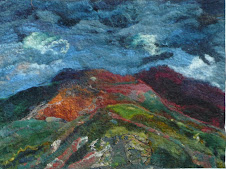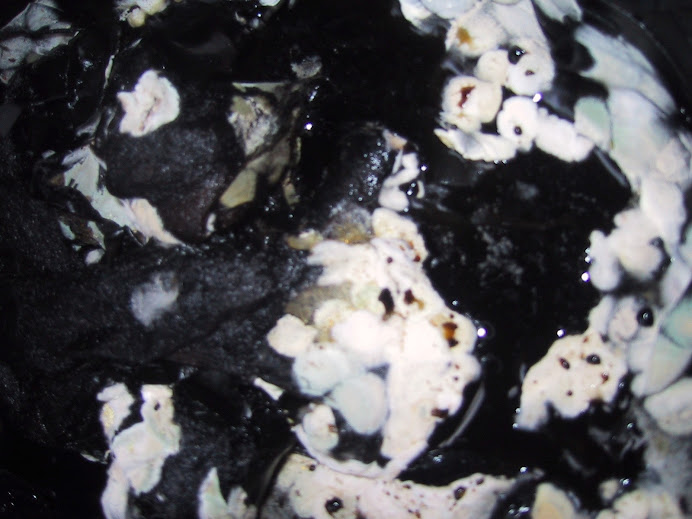Earlier on this year
Isabella Whitworth , sent me 100g of cochineal from
Lanzarote, one of the Canary Islands, where efforts are being made by the
Milana Association. to revive the cochineal industry which originally started in 1835.
Lanzarote was one of the first places that
successfully grew the cochineal bug outside South America. and certainly you see the cactus that is host for the bug everywhere in
Lanzarote and I spent one very frustrating day about ten years ago trying to track down cochineal without success.
The producers want to know how good the cochineal is so I volunteered to try it out. Recently I have been experimenting with different ways to dye cochineal. I have tried extracting the colour from the whole bugs by boiling in distilled water but in the end I reverted back to the way I have been doing it for a while which I found originally in Trudy Von
Stralen's book "Indigo Madder and Marigold". ( Still one of the best introductions to natural dyeing around I think) . For me with soft water this seems to give me the best colour, but if you have hard water you might want to use distilled to extract the dye as cochineal does not like hard water.
So I ground 50g of cochineal bugs in a coffee grinder kept for that purpose. Trudy Von
Stralen says to grind it till it is like flour and I do grind it several times. The photo looks quite gritty and grainy but in fact the fine


powder has clumped a bit.
I put the ground cochineal into soak with a teaspoon of cream of tartar and left it to
soak for 24 hours. Then I heated it- I used an electric casserole on the low heat so it takes about four hours to come to the boil and then boiled for about an hour and left to cool overnight.
At the same time I soaked my fibres overnight before
mordanting them in 12% alum and 5% cream of tartar. (For more information on
mordanting look
here.)
I added a 170g of 23
micron South African Merino tops , the fibre I use in my felting and for many of my workshops. This I heated on low till it simmered and let it simmer for about an hour. Both of the South American Dyes, cochineal and log wood, are the exception to my rule of low temperature dyeing as they fix better if simmered. The fibres were then cooled rinsed and dried. I used up the exhaust dyeing more merino, a 100g of
tussah silk and
teeswater. Altogether the 50g of cochineal dyed 970g of fibre paler and paler colours The first colour as you can see

from the comparison photo was as good as my usual cochineal.

It will be really good to have cochineal from a nearby and known source and with a lower carbon foot print too for us in Europe. I know that cochineal
production gives an income to poor Peruvian farmers but I do like to know where my dyes come from and whether workers have been paid well for their labour too.
I still have 50 g left so now I plan to play around with the mordants such as iron and oxalic acid. Cochineal is polychromatic and responds to different mordants givng purples grey and pinks. The best book for this is Fred Gerber's self published classic booklet Cochineal. A mine of information but very hard to get hold of.
I have just been given
this link to the Association Milana
 My stall: I am better pleased with this year than last but you still have to contend with the feeling you are setting up inside a shoebox. Sales were okay-just- but odd. Saturday was dreadful and I took most of my money on Sunday afternoon.
My stall: I am better pleased with this year than last but you still have to contend with the feeling you are setting up inside a shoebox. Sales were okay-just- but odd. Saturday was dreadful and I took most of my money on Sunday afternoon.
 I am on the right and Carys is on the left. Carys is one of two who make the most fabulous unusual and interesting clothes from recycled garments , although they say they are upcycled. Below is me and Hayley the other one of the two girls -snapped by Enys when I wasn't looking.
I am on the right and Carys is on the left. Carys is one of two who make the most fabulous unusual and interesting clothes from recycled garments , although they say they are upcycled. Below is me and Hayley the other one of the two girls -snapped by Enys when I wasn't looking. You can find Cary's and Hayley's work here and here Every year Enys and I ransack their stall. Enys bought two summer dresses but I brought the cream top with a bustle to go with the dress I bought last year. It is great fun and of the things I most enjoy about Wonderwool
You can find Cary's and Hayley's work here and here Every year Enys and I ransack their stall. Enys bought two summer dresses but I brought the cream top with a bustle to go with the dress I bought last year. It is great fun and of the things I most enjoy about Wonderwool I am sure why this photo is at an angle. Enys this one is down to you! It shows off my bustle cardigan. I just love the quirkiness of these clothes:)
I am sure why this photo is at an angle. Enys this one is down to you! It shows off my bustle cardigan. I just love the quirkiness of these clothes:) Here is Enys but wearing her gorgeous coat over her dress so you can't see it!
Here is Enys but wearing her gorgeous coat over her dress so you can't see it! and my fibres.
and my fibres.


























